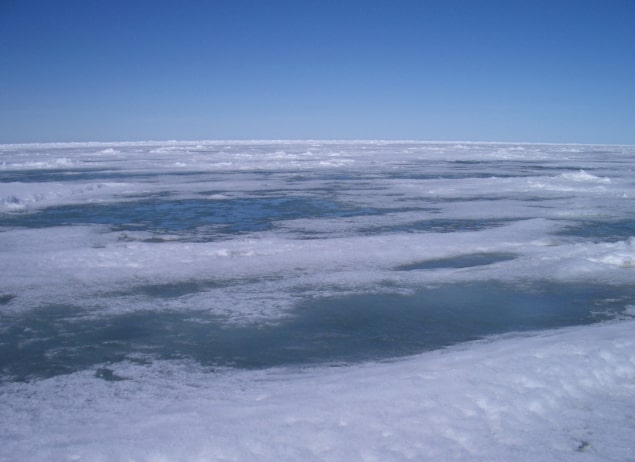
A model that simulates magnets can also reproduce pools of water on Arctic sea ice from just one real-world measurement. Researchers in the US and UK adapted the Ising statistical model of phase transitions in ferromagnets to recreate melt-pond patterns. Characterizing the distribution of meltwater at small scales could improve climate models and predict ice loss better.
As climate changes, warming is expected to be especially rapid at high latitudes. In the Arctic, a lengthening melt season over the last few decades has already reduced the volume and extent of sea ice, with year-on-year ice-loss rates generally exceeding predictions.
One reason for the failure of models to predict this loss accurately might lie in how they account for melt ponds. The formation and growth of these ponds, which occurs at the transition between sea ice and open ocean, includes a positive feedback loop that makes the system especially sensitive.
“Pond evolution largely controls sea-ice albedo, a key parameter in climate modelling and one of the most important – and least understood — processes in determining the role of sea ice in the climate system,” says Kenneth Golden of the University of Utah, US.

As melt ponds form on the sea-ice surface, highly-reflective ice and snow are replaced by darker pools of water. The meltwater absorbs more solar radiation and warms up more than the ice that it replaces; the extra energy can trigger additional melting in its surroundings. When the melt pond penetrates the full thickness of the ice, warmer ocean water floods in from below, accelerating the process.
Existing descriptions of pond formation in global climate models consider the overall volume of meltwater but not its surface distribution. Yet, because the albedo change caused by melt ponds is a surface process, and because the rate at which ponds conduct heat to their surroundings depends on their perimeter, understanding the rules governing melt pond sizes is crucial for climate modelling.
Sea-ice spin
The standard Ising model comprises a lattice of interacting particles, each of which is assigned a spin value that is either up or down. To capture the detailed geometry of melt ponds, Golden, with colleagues at Northumbria University, UK, the University of Dayton, US, and the University of Utah, US, created a version where the lattice represents the sea-ice surface, and each node a pixel of either ice or liquid water.
Starting with a random input configuration that does not resemble the real-world, each node interacts with its neighbours until the system settles on a local low-energy state. With a lattice spacing of 1 metre – the length scale over which Arctic ice exhibits significant topographic differences – the pattern that emerges from the energy-minimization process closely matches the melt-pond distribution seen in real life. For example, both real and modelled ponds scale in size according to the same power law, and both form more complex, fractal shapes when they grow larger than 100 sq. m.
“The approach could ultimately lead to a framework for representing pattern formation occurring at spatial scales smaller than the grid spacing used in global climate models, which currently track meltwater volume without representing its spatial distribution,” says Golden.
Other parameters that describe ferromagnetic behaviour in the original Ising model also have real-world analogues in the version adapted for sea-ice. The global magnetic field, for example, which conventionally governs how likely particle spins are to align as up or down, now corresponds to solar energy input, making each lattice point more or less likely to be water or ice. The strength of coupling between neighbouring particle spins, meanwhile, now describes heat flow between water and ice in adjacent pixels.
Although Golden and colleagues ran their model with zero global field and an infinite coupling strength, changing these parameters after the initial process could perturb a realistic pond arrangement from its metastable state into an alternative low-energy configuration. In this way, the researchers might simulate how sea ice evolves as melt ponds respond to changing environmental conditions.
Golden and colleagues reported their findings in New Journal of Physics.



